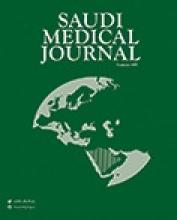REVIEW ARTICLE
Sawbones laboratory in orthopedic surgical training
Hetaimish discuss the organization of sawbones simulation in orthopedic surgical training to enhance trainee’s future learning; explore the implications of sawbones simulation in orthopedic surgical teaching and evaluation; scrutinize the suitability of practicing on sawbones at the simulation laboratory to improve orthopedic trainee learning; and to propose some recommendations for future enhancement of sawbones simulation-based learning in orthopedic surgical training. The author conclude that sawbones simulation laboratories provide the residents with flexibility in learning that align with their working hour limitations and disclosed the constructive educational impacts of sawbones simulation in orthopedic surgical training. Future directions were discussed to enhance the applications of this learning opportunity.
see page 348
SYSTEMATIC REVIEW
Influence of the CYP4F2 polymorphism on the risk of hemorrhagic complications in coumarin-treated patients
Chen et al evaluate the impact of the CYP4F2 polymorphism on bleeding complications and over-anticoagulation due to coumarin. A comprehensive literature search was performed to look for eligible studies published prior to February 2015 in EMBASE and PubMed. References were strictly identified by inclusion and exclusion criteria, and authors of primary studies were consulted for additional information and data. The authors found that the effect of the CYP4F2 polymorphism on the risk of bleeding, or over-anticoagulation to coumarin failed to reach a level of statistical significance. The subtle influence of the CYP4F2 polymorphism could not be excluded and should be further investigated.
see page 361
ORIGINAL ARTICLE
The efficacy of diffusion weighted imaging and apparent diffusion coefficients mapping for liver metastasis of colonic adenocarcinomas
Metin et al conclude that the use of apparent diffusion coefficient (ADC) values alone can be executed for the diagnosis of focal hepatic masses and also can aid in the differentiation of benign and malignant hepatic lesions. There was a statistically significant difference in terms of ADC values and ratio index (RI) between poorly-differentiated adenocarcinoma and moderately-differentiated adenocarcinoma plus well-differentiated adenocarcinomas. Poorly-differentiated adenocarcinomas have the lowest ADC values and highest RI values among other groups. The diagnoses of liver metastases were confirmed with biopsy, surgery, and follow-up imaging findings. Twenty-six patients with 94 liver metastasis were included in the study.
Receiver operating characteristics curves showing the A) mass diameter and apparent diffusion coefficient (ADC) values of masses for poorly and well-differentiated groups and B) poorly and moderately-differentiated groups with regard to diameter and ADC values of masses
see page 379
CASE REPORT
Pseudo Class III malocclusion
Al-Hummayani et al presents a case of a 16-year-old female patient, complains of the appearance of her anterior teeth, with both upper and lower incisors being severely retruded and supraerupted. She was diagnosed with pseudo Class III malocclusion; the incisors are in an edge-to-edge relationship, but due to incisal interference between the upper and the lower incisors, an anterior functional mandibular shift was created and the teeth fall in deep anterior crossbite as she closes in centric occlusion. Skeletally, she was Class I; hence, this confirms the pseudo Class III malocclusion diagnosis. Phase II treatment was performed with fixed appliances (braces) to align teeth and have proper over bite and overjet and to close posterior open bite, this phase was accomplished within 11 months.
Intra-oral photos (frontal and side views) after insertion of the appliance showing: A & B) the inverted labial bow, and C & D) upper view of the patient cast with the appliance showing 2 Adams clasps and helical “Z” bow spring
see page 450
- Copyright: © Saudi Medical Journal
This is an open-access article distributed under the terms of the Creative Commons Attribution-Noncommercial-Share Alike 3.0 Unported, which permits unrestricted use, distribution, and reproduction in any medium, provided the original work is properly cited.








